
43 Best SaaS Website Examples Designs of 2025 for Inspired Innovation
Are you looking to explore the dynamic world of Software as a Service (SaaS) websites? Join me on a journey through the digital landscape as we uncover the power and potential of SaaS platforms. This blog delves into various SaaS website examples, dissecting their design, functionality, and user experience to glean insights and inspiration. Whether you’re a seasoned entrepreneur seeking innovative solutions or a curious enthusiast eager to discover the latest trends, this exploration of SaaS website examples promises to ignite your creativity and broaden your perspective on the ever-evolving realm of online business.
Understanding SaaS Websites
SaaS, or Software as a Service, is a software distribution model in which applications are hosted by the service provider and made available to customers over the Internet, typically through a subscription-based pricing model. SaaS websites are the online portals through which businesses showcase their software offerings, providing users with a seamless and accessible experience.
SaaS websites offer numerous benefits to businesses and consumers alike. For businesses, they provide a cost-effective and scalable solution, enabling them to reach a global audience without requiring extensive infrastructure investments. Conversely, consumers benefit from the convenience of accessing software solutions from any device with an internet connection, eliminating the need for complex installations or updates.
The Anatomy of a Successful SaaS Website
A well-designed SaaS website is more than just an aesthetically pleasing digital presence; it is a strategic tool that drives user engagement, conversions, and business growth. The anatomy of a successful SaaS website encompasses several essential elements:
User Interface (UI) and Navigation:
An intuitive and user-friendly interface and seamless navigation ensure a positive user experience, reducing friction and encouraging exploring the website’s features and offerings.
Branding:
Consistent and cohesive branding across all website elements, including visuals, typography, and messaging, reinforces the company’s identity and fosters brand recognition and loyalty.
Engaging Content:
Compelling and informative content, including product descriptions, feature highlights, and multimedia elements (such as videos and interactive demos), educates and captivates users, guiding them through the sales funnel.
Effective Calls-to-Action (CTAs):
Strategic placement of clear and persuasive CTAs, encouraging users to take desired actions, such as signing up for a free trial, scheduling a demo, or purchasing.
Social Proof and Testimonials: Positive reviews, case studies, and testimonials from satisfied customers instill trust and credibility, influencing potential users’ decision-making processes.
Top SaaS Website Examples
Explore our curated list of exemplary SaaS websites showcasing various industries and functionalities:
Webflow

Webflow is a versatile platform for building websites, perfect for creating SaaS website examples with its intuitive design tools and powerful hosting capabilities.
Webflow’s website truly showcases its powerful, no-code website-building capabilities. The sleek and modern design, coupled with interactive demos and visually appealing animations, immediately captivates visitors and immerses them in the platform’s intuitive user experience.
The website effectively communicates Webflow’s value proposition through clear messaging, concise feature highlights, and compelling case studies. It is an excellent resource for designers, developers, and businesses seeking to create stunning, responsive websites without coding.
Ahrefs

Ahrefs is a powerful SEO tool used to optimize websites and analyze competitors, making it a perfect choice for SaaS website examples.
The Ahrefs website exemplifies the art of educating and engaging users through comprehensive content marketing. Its vast knowledge base of SEO-focused blog posts, tutorials, and case studies showcases Ahrefs’ expertise.
It establishes the brand as a thought leader in the digital marketing industry. The clean and user-friendly interface, coupled with interactive tools and data visualizations, enables users to explore the platform’s powerful features and capabilities, fostering trust and credibility.
Mailchimp

Mailchimp, a leading email marketing platform, is a prime SaaS website example. It offers intuitive tools for businesses to engage their audience effectively.
Mailchimp’s website is a masterclass in simplicity and user-friendliness. The vibrant color palette, playful illustrations, and minimalist design create a delightful browsing experience that reflects the brand’s fun and approachable personality.
The website guides users through the various features and pricing plans, making it easy for businesses of all sizes to understand and adopt the email marketing platform. Additionally, the wealth of educational resources, including guides, templates, and integrations, empowers users to optimize their email campaigns and achieve better results.
Trello

Trello, a popular project management tool, is a prime SaaS website example, offering intuitive collaboration features for teams.
Trello’s website is a testament to the power of clear and concise communication. The website effectively conveys the project management tool’s simplicity and flexibility with a straightforward design and intuitive navigation. Visuals like board examples and team collaboration illustrations help users visualize the platform’s functionality and understand how it can streamline their workflows. Additionally, the website showcases real-world use cases and integrations, demonstrating Trello’s versatility and adaptability across various industries and teams.
Slack

Slack is a prime SaaS website example. It offers seamless communication and collaboration tools, revolutionizing remote work dynamics globally.
Slack’s website embodies the brand’s mission of fostering seamless communication and collaboration. The clean and modern design, coupled with an emphasis on teamwork and productivity, creates a cohesive and engaging user experience. Through interactive demos and video walkthroughs, the website effectively highlights Slack’s core features, such as channels, file sharing, and integrations. Furthermore, including customer testimonials and case studies from diverse industries reinforces Slack’s credibility and effectiveness as a communication platform for teams of all sizes and across various sectors.
Asana

Asana is a leading project management tool, often cited as a SaaS website example. It offers intuitive task tracking and collaboration features.
Asana’s website is a prime example of effectively communicating the value of a complex work management solution. The website’s clean and minimalist design allows the platform’s features and capabilities to take center stage. Through clear and concise messaging, interactive demos, and comprehensive guides, the website educates users on the power of Asana’s project management tools, enabling them to visualize how the platform can streamline their workflows and increase productivity. Additionally, the website showcases real-world use cases and customer success stories, further solidifying Asana’s position as a trusted solution for teams of all sizes.
Canva
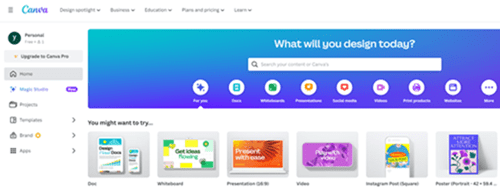
Create stunning designs effortlessly with Canva, a leading SaaS website example. Its intuitive interface and vast library empower users to unleash their creativity.
Canva’s website is a visual delight, reflecting the brand’s commitment to empowering users to create stunning designs easily. The vibrant color palette, playful illustrations, and user-friendly interface immediately engage visitors and convey the platform’s intuitive and accessible nature. The website effectively showcases Canva’s extensive templates, design tools, and collaboration features through interactive demos and video tutorials. Additionally, including customer testimonials and educational resources, such as design tips and tutorials, further enhances the user experience and establishes Canva as a go-to solution for individuals and businesses seeking to elevate their visual content.
HubSpot

HubSpot, a leading CRM platform, offers powerful tools for SaaS website examples, streamlining marketing, sales, and customer service.
HubSpot’s website is a comprehensive resource for businesses seeking to optimize their marketing, sales, and customer service efforts. With a clean and modern design, the website effectively communicates the platform’s extensive suite of tools and features through clear messaging, interactive demos, and comprehensive guides. The website excels in showcasing real-world use cases and customer success stories, demonstrating the impact of HubSpot’s solutions on businesses of various sizes and industries. Additionally, the wealth of educational resources, including blog posts, webinars, and certifications, establishes HubSpot as a thought leader in the inbound marketing and sales space.
Zapier

Automate workflows effortlessly with Zapier, connecting apps for seamless integration. Perfect for a SaaS website example.
Zapier’s website is a prime example of effectively communicating the value of automation and integration. With a clean and user-friendly design, the website effectively showcases the platform’s ability to connect various web applications and streamline workflows. Through interactive demos and video walkthroughs, users can visualize how Zapier’s no-code automation capabilities can save time and increase productivity. Additionally, the website provides a comprehensive library of pre-built integrations, enabling users to explore the vast possibilities of automating their processes across multiple tools and platforms.
Zendesk
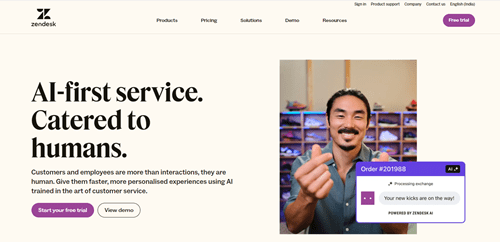
Zendesk is a leading SaaS website example, offering customer service solutions to streamline support processes and enhance user experiences.
Zendesk’s website is a comprehensive resource for businesses seeking to elevate their customer service and engagement strategies. With a modern and visually appealing design, the website effectively communicates the platform’s powerful suite of tools and features through clear messaging, interactive demos, and case studies. The website showcases the platform’s flexibility and scalability, catering to businesses of all sizes and industries. Additionally, including customer testimonials, success stories, and a wealth of educational resources, such as guides and webinars, establishes Zendesk as a trusted partner in delivering exceptional customer experiences.
Shopify

Shopify is a leading SaaS website example, empowering businesses to create online stores easily. Its user-friendly interface, customizable templates, and robust features make it ideal for entrepreneurs of all levels. Whether selling products or services, Shopify streamlines the process, from inventory management to payment processing, ensuring a seamless online shopping experience for merchants and customers.
Shopify’s website reflects the platform’s commitment to empowering entrepreneurs and businesses to succeed in e-commerce. With a clean and modern design, the website effectively showcases the platform’s extensive tools and features for creating and managing online stores. Through interactive demos, video tutorials, and success stories, the website educates users on the power of Shopify’s e-commerce solutions, enabling them to visualize how the platform can help them grow their online presence and drive sales. Additionally, including educational resources, such as blog posts and guides, further enhance the user experience and establishes Shopify as a trusted partner for businesses of all sizes.
Dropbox

Dropbox is a popular cloud storage service that epitomizes a SaaS website example. With its seamless file sharing, collaboration features, and cross-platform accessibility, Dropbox revolutionizes how individuals and businesses manage their digital assets.
Dropbox’s website is a masterclass in communicating the value of cloud storage and file-sharing solutions. With a clean and minimalist design, the website highlights the platform’s core features and benefits, such as secure storage, easy collaboration, and seamless file access across devices. Through interactive demos and visually appealing illustrations, the website educates users on the convenience and efficiency of Dropbox’s solutions. Additionally, including customer testimonials and case studies from diverse industries reinforces the platform’s credibility and adaptability across various sectors.
Grammarly

Grammarly, a popular writing assistant, is a prime SaaS website example. Offering grammar checks, style suggestions, and plagiarism detection, it’s a go-to tool for writers worldwide.
Grammarly’s website is a prime example of effective communication of the value of a writing assistant tool. With a clean and modern design, the website effectively showcases the platform’s powerful features, such as grammar checking, plagiarism detection, and tone analysis. Through interactive demos and clear messaging, the website educates users on the benefits of using Grammarly, enabling them to visualize how the tool can improve their writing skills and produce high-quality content. Additionally, including customer testimonials and success stories further reinforces the platform’s credibility and effectiveness across various industries and disciplines.
Atlassian
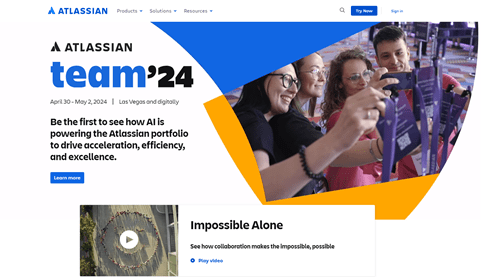
Atlassian, a leading software company, offers a suite of tools for software development, collaboration, and project management. Their flagship products, Jira and Confluence, are widely used in the industry. These tools are accessible through the cloud, making them a prime SaaS website example for teams globally.
Atlassian’s website is a comprehensive resource for teams seeking to streamline their collaboration and project management processes. With a clean and modern design, the website effectively communicates the value of Atlassian’s suite of tools, including Jira, Confluence, and Trello. Through interactive demos, case studies, and clear messaging, the website educates users on the power of these tools in fostering seamless teamwork, efficient task management, and effective knowledge sharing. Additionally, including customer testimonials and success stories from diverse industries reinforces Atlassian’s position as a trusted partner for teams of all sizes and across various sectors.
Intercom

Intercom is a versatile customer messaging platform often integrated into SaaS websites. For instance, businesses can engage visitors, offer support, and gather insights seamlessly. As a prime SaaS website example, Intercom enhances user experience and fosters meaningful interactions throughout the customer journey.
Intercom’s website is a prime example of effectively communicating the value of a customer communication platform. With a clean and modern design, the website effectively showcases the platform’s powerful features, such as chat support, customer engagement, and conversational marketing. Through interactive demos, video walkthroughs, and clear messaging, the website educates users on the benefits of using Intercom to deliver exceptional customer experiences across multiple touchpoints. The website highlights real-world use cases and success stories, demonstrating how businesses of various sizes and industries have leveraged Intercom to streamline their sales, marketing, and support processes. Additionally, including educational resources, such as guides and webinars, further enhances the user experience and establishes Intercom as a thought leader in customer communication and engagement.
Notion
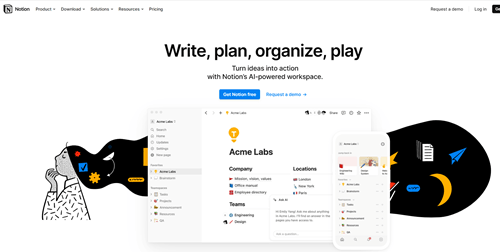
Notion is a versatile productivity tool with features like note-taking, project management, and database creation. Due to its intuitive interface, collaborative capabilities, and customizable functionality, it’s often hailed as a prime SaaS website example.
Notion’s website is a testament to the platform’s versatility and flexibility as an all-in-one workspace. With a clean and minimalist design, the website effectively communicates the power of Notion’s tools for note-taking, task management, knowledge sharing, and collaboration. The website showcases the platform’s ability to adapt to various use cases and workflows through interactive demos and visually appealing illustrations, enabling users to visualize how Notion can streamline their productivity and organization. Additionally, including customer testimonials and case studies from diverse industries reinforces Notion’s credibility and adaptability across various sectors and team structures.
Zoom

Zoom, a leading video conferencing platform, is a quintessential SaaS website example. Offering seamless virtual communication, it epitomizes the efficiency and accessibility that SaaS solutions provide in today’s interconnected world.
Zoom’s website is a prime example of communicating the value of video conferencing and online meeting platforms. The website’s clean and modern design highlights Zoom’s core features, such as high-quality video and audio, screen sharing, and virtual backgrounds. Through interactive demos and video walkthroughs, the website educates users on the ease of use and reliability of Zoom’s solutions, enabling them to visualize how the platform can facilitate seamless remote collaboration and communication. Additionally, including customer testimonials and case studies from diverse industries reinforces Zoom’s credibility and effectiveness across various sectors and team structures.
Figma
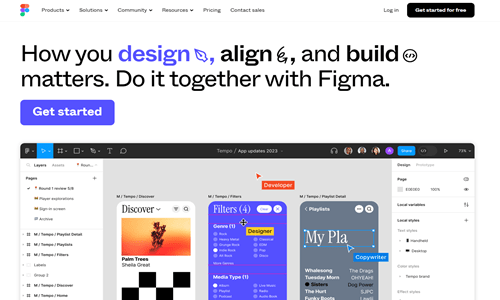
Figma’s website is a visual delight, reflecting the platform’s commitment to empowering designers and teams to collaborate and create stunning digital products. With a clean and modern design, the website effectively showcases Figma’s powerful design and prototyping tools through interactive demos, video tutorials, and visually appealing illustrations. The website highlights the platform’s real-time collaboration features, enabling users to visualize how Figma can streamline their design processes and foster effective teamwork. Additionally, including customer testimonials and case studies from diverse industries reinforces Figma’s credibility and effectiveness across various design disciplines and team structures.
Airtable
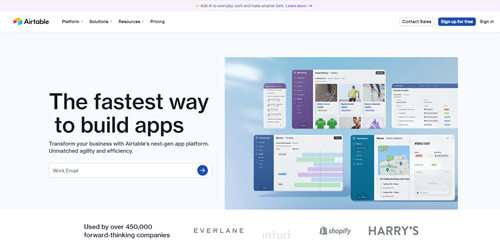
Airtable is a versatile cloud-based platform that combines the features of a spreadsheet with a database. It’s used across various industries, serving as a dynamic tool for project management, CRM, and more. For instance, a SaaS website example might utilize Airtable to manage customer data, track subscriptions, and coordinate marketing campaigns seamlessly.
Airtable’s website is a prime example of effectively communicating the value of a powerful spreadsheet-database hybrid solution. With a clean and modern design, the website effectively showcases Airtable’s ability to organize and manage data flexibly and intuitively. Through interactive demos, video tutorials, and clear messaging, the website educates users on the platform’s extensive features and capabilities, enabling them to visualize how Airtable can streamline their data management processes and support various workflows. Additionally, including customer testimonials and case studies from diverse industries reinforces Airtable’s credibility and adaptability across various sectors and use cases.
Calendly
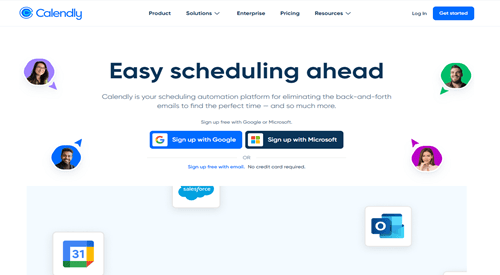
Calendly is a popular SaaS website example that simplifies scheduling by allowing users to book appointments seamlessly. Its intuitive interface and customizable features make it a top choice for businesses and professionals seeking efficient time management solutions.
Calendly’s website is a prime example of effectively communicating the value of a scheduling platform. The website’s clean and modern design highlights Calendly’s core features, such as easy appointment scheduling, calendar integration, and customizable booking pages. Through interactive demos and clear messaging, the website educates users on the convenience and efficiency of using Calendly to streamline their scheduling processes, enabling them to visualize how the platform can save time and improve productivity. Additionally, including customer testimonials and case studies from diverse industries reinforces Calendly’s credibility and effectiveness across various sectors and team structures.
Stripe

Stripe is a leading payment processing platform often integrated into SaaS website examples. With its robust API and seamless checkout experience, Stripe empowers businesses to accept payments securely, making it an indispensable tool for e-commerce and subscription-based platforms.
Stripe’s website is a testament to its role in revolutionizing online payment processing. With a sleek and modern design, the website effectively showcases Stripe’s powerful suite of payment solutions. Through clear messaging, interactive demos, and case studies, the website educates users on the ease of integrating Stripe into their websites and applications, enabling seamless transactions and revenue management. Additionally, including customer testimonials and success stories from businesses of all sizes reinforces Stripe’s credibility and effectiveness in facilitating secure online payments.
Google Workspace
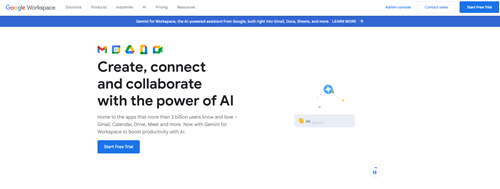
Google Workspace is a suite of productivity tools like Gmail, Drive, Docs, and more, which is ideal for seamless collaboration in business. As a SaaS website example, it offers cloud-based solutions for efficient communication and workflow management, enhancing productivity and teamwork.
Google Workspace’s website is a comprehensive resource for businesses seeking to enhance collaboration and productivity through cloud-based tools. With a clean and minimalist design, the website effectively communicates the value of Google Workspace’s suite of applications, including Gmail, Drive, Docs, and Meet. Through interactive demos, video tutorials, and case studies, the website demonstrates how Google Workspace can streamline communication, document management, and virtual collaboration, empowering teams to work more efficiently regardless of location or device.
Salesforce

Salesforce, a leading CRM platform, offers businesses powerful tools for managing customer relationships. With its robust features and customizable interface, Salesforce is like a SaaS website example, providing a cloud-based solution for companies to streamline sales, marketing, and customer service operations.
Salesforce’s website is a prime example of effective communication for the value of a comprehensive customer relationship management (CRM) platform. With a modern and visually appealing design, the website showcases Salesforce’s extensive tools for sales, marketing, customer service, and analytics. Through clear messaging, interactive demos, and case studies, the website educates users on how Salesforce can help businesses of all sizes build stronger customer relationships, drive sales growth, and make data-driven decisions. Additionally, including customer testimonials and success stories reinforces Salesforce’s position as a trusted partner in digital transformation.
QuickBooks

QuickBooks is a popular accounting software that streamlines financial tasks for businesses. It’s a SaaS website example that provides cloud-based services for managing invoices, expenses, and payroll, accessible anytime, anywhere.
QuickBooks’ website is a comprehensive resource for businesses seeking to streamline their accounting and financial management processes. With a clean and user-friendly design, the website effectively communicates the value of QuickBooks’ suite of accounting software solutions for small businesses, self-employed individuals, and accounting professionals. Through interactive demos, video tutorials, and case studies, the website educates users on how QuickBooks can simplify invoicing, expense tracking, payroll management, and tax preparation, enabling them to focus more on growing their business.
Adobe Creative Cloud
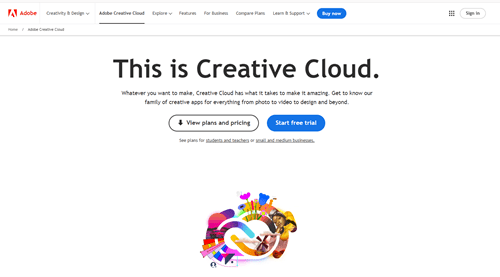
Creative Cloud offers a suite of Adobe applications through a SaaS website example. Users can access industry-standard tools like Photoshop, Illustrator, and Premiere Pro on a subscription basis. This model provides flexibility and continuous updates, catering to diverse creative needs.
Adobe Creative Cloud’s website is a visual masterpiece, reflecting the platform’s commitment to empowering creative professionals with industry-leading design and multimedia tools. With a sleek and modern design, the website effectively showcases Adobe Creative Cloud’s extensive suite of applications, including Photoshop, Illustrator, InDesign, and Premiere Pro. Through interactive demos, video tutorials, and inspiring case studies, the website demonstrates how Adobe Creative Cloud can unleash creativity, streamline workflows, and bring ideas to life across various creative disciplines and industries.
Monday.com
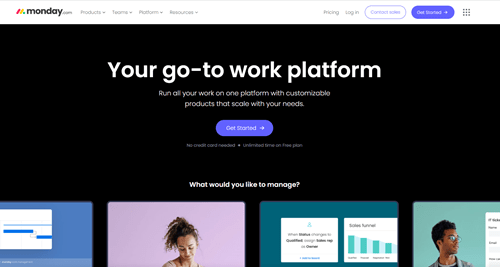
Monday.com is a prime SaaS website example, offering intuitive project management solutions. Its user-friendly interface and customizable features make it a go-to platform for teams worldwide.
Monday.com’s website is a comprehensive resource for teams seeking to streamline their work processes and project management efforts. With a modern and visually appealing design, the website effectively communicates the versatility and flexibility of Monday.com’s work operating system. Through clear messaging, interactive demos, and case studies, the website demonstrates how Monday.com can centralize communication, track progress, and automate repetitive tasks, enabling teams to collaborate and achieve their goals more efficiently.
Hootsuite
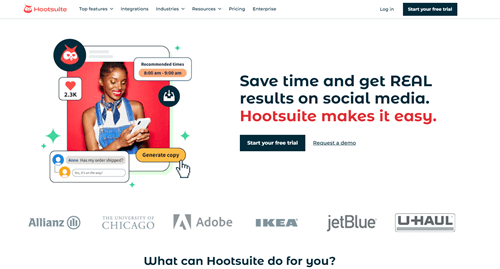
Hootsuite is a popular social media management tool, a prime SaaS website example. Offering streamlined scheduling, analytics, and content curation, it epitomizes the efficiency and scalability of a Software-as-a-Service platform.
Hootsuite’s website is a prime example of effective communication and the value of social media management solutions for businesses and organizations. The website’s clean and modern design highlights Hootsuite’s core features, such as social media scheduling, monitoring, and analytics. Through interactive demos, video tutorials, and case studies, the website educates users on how Hootsuite can streamline social media marketing efforts, amplify brand presence, and drive engagement across multiple platforms. Additionally, including customer testimonials and success stories reinforces Hootsuite’s credibility and effectiveness in helping businesses succeed in the digital landscape.
DocuSign

DocuSign, a leader in electronic signature solutions, is a prime SaaS website example. It offers seamless document signing and management, illustrating the power and convenience of a Software-as-a-Service platform.
DocuSign’s website is a comprehensive resource for businesses seeking to streamline document signing and agreement processes. With a modern and visually appealing design, the website effectively communicates the value of DocuSign’s eSignature solution for securely signing, sending, and managing documents online. The website educates users on how DocuSign can accelerate agreement workflows, reduce paperwork, and improve compliance through clear messaging, interactive demos, and case studies. This enables businesses to close deals faster and enhance the overall customer experience. Additionally, including customer testimonials and success stories reinforces DocuSign’s position as a trusted partner in digital transaction management.
Buffer

Buffer is a prime example of a SaaS website offering business social media management tools. Buffer’s intuitive interface and robust features simplify scheduling, analyzing, and managing social media content across various platforms. Its seamless integration capabilities make it a favorite among marketers and social media enthusiasts.
Buffer’s website is a prime example of effectively communicating the value of social media management solutions for businesses and individuals. The website’s clean and intuitive design highlights Buffer’s core features, such as social media scheduling, analytics, and engagement. Through interactive demos, video tutorials, and case studies, the website educates users on how Buffer can streamline social media workflows, amplify brand presence, and drive meaningful engagement across various platforms. Including customer testimonials and success stories further reinforces Buffer’s credibility and effectiveness in helping users succeed in the digital landscape.
FreshBooks
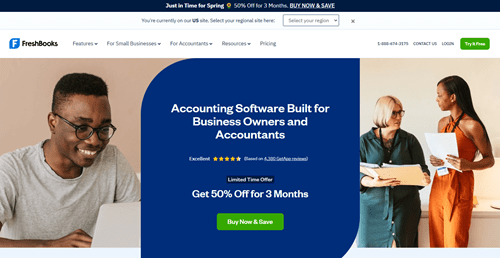
FreshBooks is a top-notch SaaS website that provides examples of accounting and invoicing software. Ideal for freelancers and small businesses, It streamlines financial tasks with its user-friendly interface and comprehensive features. From creating professional invoices to tracking expenses, FreshBooks simplifies accounting processes, empowering users to focus more on their core business activities.
FreshBooks’ website is a comprehensive resource for freelancers and small businesses seeking to streamline their accounting and invoicing processes. With a user-friendly design, the website effectively communicates the value of FreshBooks’ cloud-based accounting software for managing expenses, tracking time, and invoicing clients. Through clear messaging, interactive demos, and case studies, the website educates users on how FreshBooks can simplify financial management tasks, improve cash flow, and save time on administrative work. Including customer testimonials and success stories showcases FreshBooks’ effectiveness in helping users achieve financial success.
Wrike
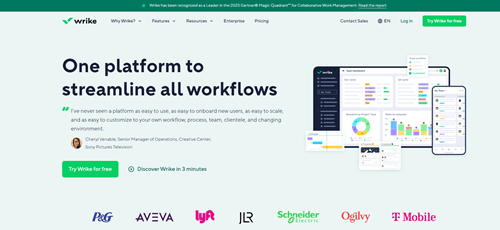
Wrike exemplifies a SaaS website dedicated to project management solutions. With its versatile platform, Wrike facilitates collaboration, task management, and project tracking for teams of all sizes. Its customizable workflows and real-time communication features make it indispensable for increasing productivity and streamlining project workflows in diverse industries.
Wrike’s website is a comprehensive resource for teams seeking to streamline their project management and collaboration efforts. With a modern and visually appealing design, the website effectively communicates the versatility and scalability of Wrike’s work management platform. Through clear messaging, interactive demos, and case studies, the website demonstrates how Wrike can centralize project communication, track progress, and optimize resource allocation, enabling teams to work more efficiently and effectively. Including customer testimonials and success stories showcases Wrike’s impact on improving productivity and driving project success across various industries.
SurveyMonkey

SurveyMonkey is a quintessential SaaS website example for online survey creation and data analysis. Whether conducting market research, gathering customer feedback, or organizing employee satisfaction surveys, SurveyMonkey offers a user-friendly platform with robust analytics capabilities. Its customizable survey templates and insightful reporting tools empower users to make informed decisions based on actionable data insights.
SurveyMonkey’s website is a prime example of effective communication of the value of online surveys and feedback-gathering solutions for businesses and organizations. With a clean and intuitive design, the website highlights SurveyMonkey’s core features, such as customizable survey templates, robust analytics, and easy distribution options. Through interactive demos, video tutorials, and case studies, the website educates users on how SurveyMonkey can streamline the feedback collection process, gather actionable insights, and make data-driven decisions to improve products, services, and processes. Including customer testimonials and success stories reinforces SurveyMonkey’s reputation as a trusted survey platform for businesses worldwide.
Mixpanel

Mixpanel shines as a leading SaaS website example in product analytics. Designed to help businesses understand user behavior and optimize their products, Mixpanel offers advanced analytics and segmentation tools. Mixpanel provides invaluable insights to drive product development and enhance user experience, from tracking user interactions to analyzing conversion funnels.
Mixpanel’s website is a comprehensive resource for businesses seeking to understand user behavior and drive product innovation through analytics. With a sleek and modern design, the website effectively communicates the power of Mixpanel’s advanced analytics platform for tracking user interactions, measuring engagement, and optimizing conversion rates. The website demonstrates how Mixpanel can help businesses make data-driven decisions to improve user experiences, increase retention, and drive growth through clear messaging, interactive demos, and case studies. Including customer testimonials and success stories showcases Mixpanel’s impact on driving business success through actionable insights.
Zoho CRM
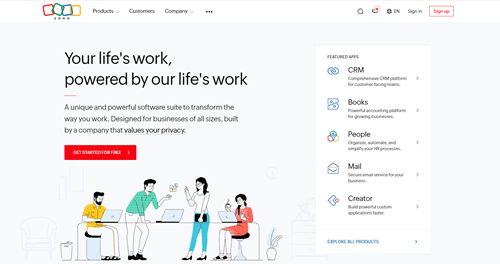
Zoho CRM is a leading SaaS website example for managing customer relationships. With its intuitive interface and robust features, businesses can streamline sales processes and improve customer interactions effortlessly.
Zoho CRM’s website is a prime example of effective communication of the value of a comprehensive customer relationship management (CRM) solution for businesses of all sizes. The website’s clean and intuitive design highlights Zoho CRM’s core features: lead management, sales automation, and customer support. Through interactive demos, video tutorials, and case studies, the website educates users on how Zoho CRM can streamline sales processes, improve customer relationships, and drive revenue growth. Including customer testimonials and success stories reinforces Zoho CRM’s reputation as a trusted CRM platform for businesses worldwide.
Miro

Miro is a collaborative online whiteboard platform, a prime example of a SaaS website. It enables teams to ideate, brainstorm, and visualize ideas in real time, fostering creativity and enhancing productivity across distributed teams.
Miro’s website is a comprehensive resource for teams seeking to enhance collaboration and creativity through online whiteboarding and visual collaboration tools. With a modern and visually appealing design, the website effectively communicates the versatility and flexibility of Miro’s digital workspace platform. The website demonstrates how Miro can facilitate remote collaboration, creativity, and brainstorming sessions through clear messaging, interactive demos, and case studies, enabling teams to work together seamlessly regardless of location. Including customer testimonials and success stories showcases Miro’s impact on driving innovation and productivity for teams across various industries and use cases.
Worksome
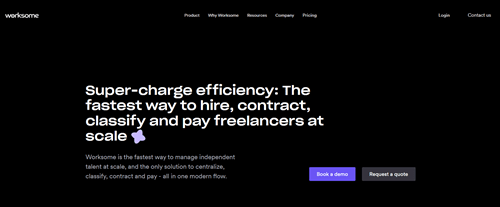
Worksome offers a SaaS website example for flexible workforce management. Businesses can efficiently source, manage, and pay freelancers through its platform, optimizing project workflows and driving cost savings.
Worksome’s platform offers a comprehensive solution for managing freelancers and remote workers. With its intuitive interface and robust features, Worksome simplifies finding, hiring, and collaborating with freelance talent. From project tracking to invoicing, Worksome provides businesses with the tools to streamline their freelance operations effectively.
Ramp

Ramp is a SaaS website example of revolutionizing corporate spend management. Its intelligent platform provides insights into company expenses, empowering businesses to make informed decisions and control costs effectively.
Ramp is a cutting-edge corporate card and expense management platform built for modern businesses. With Ramp, companies can easily issue cards to employees, set spending limits, and track expenses in real time. Ramp helps businesses optimize their finances and control costs effectively by providing insights into spending patterns and offering automated reconciliation.
ClickUp
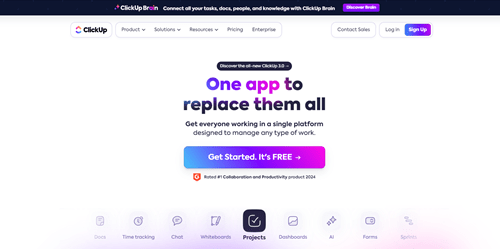
ClickUp is a comprehensive project management solution that epitomizes a SaaS website example. With customizable features and integrations, teams can collaborate seamlessly, streamline workflows, and achieve project success efficiently.
ClickUp is a powerful project management and productivity platform designed to streamline collaboration and task management. With customizable workflows, goal tracking, and time management features, ClickUp empowers teams to work more efficiently and achieve their goals. Whether managing a small team or a large enterprise, ClickUp offers the flexibility and scalability to meet your needs.
Copilot

Copilot is a SaaS website example offering AI-driven code review and collaboration tools. Developers can enhance code quality, increase productivity, and accelerate software development cycles with its intelligent insights and suggestions.
Copilot is an innovative code collaboration platform that enables developers to collaborate seamlessly on coding projects. With features like real-time editing, code review, and pair programming support, Copilot enhances team productivity and code quality. It provides the tools to collaborate effectively and build better Software, whether working on a small script or a large-scale application.
Spline

Spline provides a SaaS website example for effortlessly creating stunning 3D animations and visualizations. With its user-friendly interface and powerful features, designers and developers can easily bring their ideas to life.
Spline is an advanced 3D animation and visualization tool designed for designers, animators, and creative professionals. With its intuitive interface and powerful rendering engine, Spline makes creating stunning 3D graphics and animations easy. Whether designing a product prototype, creating a visual effect, or crafting a virtual environment, Spline offers the tools and flexibility to bring your ideas to life.
Butter
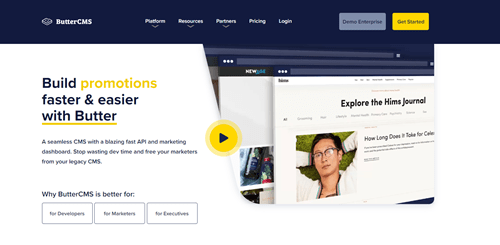
Butter is a prime example of a SaaS website for customer feedback and engagement. Its platform enables businesses to collect, analyze, and act on customer feedback in real-time, fostering stronger relationships and driving growth.
Butter is a modern content management system (CMS) for publishers, media companies, and content creators. With its intuitive interface and robust publishing tools, Butter makes it easy to create, manage, and distribute digital content across multiple channels. Whether you’re publishing articles, videos, or podcasts, Butter offers the flexibility and features to help you reach your audience effectively.
Juno
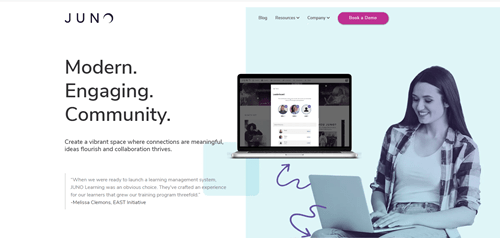
Juno offers a SaaS website example for optimizing fleet management and logistics operations. With its innovative platform, businesses can track vehicles, manage routes, and streamline delivery processes, enhancing efficiency and customer satisfaction.
Juno is an innovative e-learning platform that provides personalized learning experiences for students of all ages. With its adaptive learning algorithms and interactive content, Juno helps students master key concepts and skills at their own pace. Whether you’re studying math, science, language arts, or any other subject, Juno offers the tools and support you need to succeed academically.
Tranch
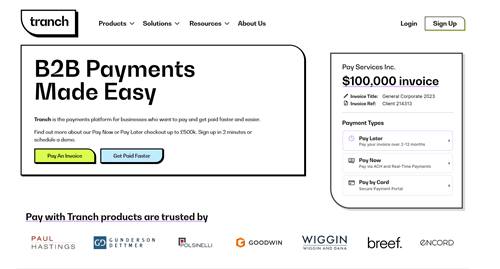
Tranch provides an example of a SaaS website for secure document management and collaboration. Its encrypted platform ensures data privacy and compliance, empowering teams to securely share, edit, and store documents in the cloud.
Tranch is a revolutionary document management platform that simplifies creating, editing, and sharing documents online. With its intuitive interface and collaboration features, Tranch makes it easy for teams to collaborate on documents in real time, track changes, and ensure version control. Whether drafting a proposal, writing a report, or creating a presentation, Tranch offers the tools to work more efficiently and effectively.
Key Components of a Great SaaS Website
Clear Value Proposition:
- Start by identifying the unique value proposition of your SaaS product. What problem does it solve for your target audience? How does it differentiate from competitors?
- Craft a succinct headline articulating your SaaS product’s primary benefit or solution. Use language that resonates with your target audience and addresses their pain points.
- Provide supporting messaging or taglines emphasizing key features, advantages, or outcomes that users can expect from using your SaaS solution.
- Use visuals such as images, icons, or animations to reinforce your value proposition visually and make it more memorable for visitors.
Intuitive Navigation:
- Conduct user research to understand how your target audience expects to navigate your website and organize content accordingly. Use clear and descriptive labels for navigation menu items.
- Consider implementing a sticky navigation bar that remains visible as users scroll down the page. This would make it easy for them to access different website sections.
- Optimize navigation for mobile devices by using a hamburger menu icon or collapsible menu to conserve screen space while still providing access to all relevant pages.
- Include breadcrumbs or a sitemap at the bottom of the page to help users understand their current location within the website and navigate to previous pages if needed.
Engaging Visual Design:
- Choose a design theme or visual style that reflects your brand identity and resonates with your target audience. Ensure consistency across all website elements, whether minimalist, bold, playful, or professional.
- Use high-quality images and videos that showcase your SaaS product in action or highlight key features and benefits. Invest in professional photography or videography to create a polished and visually appealing presentation.
- Pay attention to typography by selecting fonts that are easy to read and align with your brand personality. Experiment with font sizes, weights, and styles to create hierarchy and visual interest in your content.
- Incorporate color psychology principles to evoke the desired emotions and associations with your brand. Choose a color palette that complements your brand identity and creates a cohesive visual experience throughout the website.
Compelling Content:
- Develop a content strategy that aligns with your target audience’s needs, preferences, and pain points. Identify key topics and messaging pillars that resonate with your audience and reinforce your value proposition.
- Create informative and engaging product descriptions that clearly explain how your SaaS solution works, what problems it solves, and how it benefits users. Use storytelling techniques to make your content more relatable and compelling.
- Maintain a regularly updated blog with relevant and valuable content that educates, informs, and entertains your audience. Share industry insights, best practices, case studies, and thought leadership content to position your brand as an authority in your niche.
- Incorporate multimedia elements such as infographics, charts, and interactive content to enhance your website’s visual appeal and interactivity. Visual content tends to be more engaging and shareable, increasing the likelihood of user interaction and social sharing.
Responsive Design:
- Adopt a mobile-first approach to web design, prioritizing the user experience on smartphones and tablets. Use responsive design techniques to ensure your website layout and content adapt seamlessly to different screen sizes and resolutions.
- Test your website across various devices and browsers to identify compatibility or usability challenges. Pay attention to touch-friendly navigation, legible text sizes, and optimized image loading for mobile users.
- Implement responsive design or CSS frameworks like Bootstrap or Foundation to streamline development and ensure consistent design patterns across different devices.
- Leverage device detection and user agent sniffing techniques to serve optimized content and features based on the user’s device capabilities and preferences.
Call-to-Action (CTA):
- Strategically place CTAs throughout your website to guide visitors towards desired actions such as signing up for a free trial, downloading a resource, or contacting sales.
- Use persuasive language that communicates the benefits of taking action and motivates users to engage with your SaaS product. Focus on the value proposition and desired outcome to encourage conversions.
- Experiment with different CTA designs, placements, and messaging to identify what resonates best with your audience. A/B tests different variations to optimize performance and maximize conversion rates.
- Provide multiple opportunities for users to take action, such as inline CTAs within content, sticky CTAs that remain visible as users scroll, and exit-intent pop-ups that capture attention before users leave the website.
User-Friendly Signup Process:
- Simplify the signup process by minimizing the number of form fields and removing any unnecessary barriers to entry. Only collect essential information upfront and allow users to complete additional profile details later.
- Provide clear guidance and instructions at each signup process step to help users understand what information is required and how to proceed. Use inline validation to provide real-time feedback and reduce errors.
- Offer alternative signup options such as social login or single sign-on to streamline the process for users who prefer to use existing credentials from platforms like Google, Facebook, or LinkedIn.
- Implement progressive profiling techniques to gradually collect additional user information over time based on user interactions and engagement with your SaaS product. This lets you gather more data without overwhelming users with lengthy signup forms.
Security and Trust Signals:
- Display trust signals, such as SSL certificates, security badges, and industry certifications, to demonstrate your commitment to security and data privacy. These visual cues help build trust and reassure visitors that their sensitive information is protected.
- Highlight any security features or measures implemented within your SaaS product, such as encryption, data backups, access controls, and compliance with industry standards or regulations.
- Showcase customer testimonials, case studies, and success stories to provide social proof and demonstrate the real-world benefits and results achieved by users of your SaaS solution. Include quotes, ratings, or reviews from satisfied customers to build credibility and authority.
- Leverage third-party review platforms and ratings websites to gather unbiased customer feedback and ratings. Display these ratings and reviews on your website to showcase your reputation and track record in the industry.
SEO Optimization:
- Conduct keyword research to identify relevant search terms and topics that align with your target audience’s interests and search intent. Use these insights to optimize your website content, meta tags, headings, and URLs for relevant keywords.
- Create high-quality, valuable content that addresses common questions, challenges, and pain points your target audience faces. Publish blog posts, articles, guides, and tutorials that provide actionable insights and solutions to their problems.
- Optimize on-page elements such as title tags, meta descriptions, and heading tags to improve visibility and click-through rates in search engine results pages (SERPs). Use descriptive language and persuasive calls-to-action to entice users to click on your listings.
- Build high-quality backlinks from authoritative websites and industry publications to improve your website’s authority and credibility in the eyes of search engines. Focus on earning natural backlinks through valuable content, outreach, and relationship-building efforts.
Analytics and Tracking:
- Set up website analytics tools like Google Analytics to track key performance metrics such as traffic, engagement, conversions, and user behavior. Use these insights to understand better your audience and how they interact with your website.
- Create custom dashboards and reports to visualize and analyze important metrics and KPIs related to your SaaS business goals. Monitor trends over time and identify areas for improvement or optimization.
- Implement event and goal tracking within Google Analytics to measure specific website actions and conversions, such as form submissions, button clicks, and product signups.
- Integrate analytics data with tools and platforms like CRM systems, email marketing software, and advertising platforms to gain a holistic view of your marketing and sales funnel. Use data-driven insights to refine your strategies and optimize your SaaS website for better performance and results.
Conclusion
Building a great SaaS website requires attention to detail and a focus on key components that collectively contribute to a compelling user experience, effective communication of value proposition, and, ultimately, the conversion of visitors into customers. By incorporating clear value propositions, intuitive navigation, engaging visual design, compelling content, responsive design, strategic calls-to-action, user-friendly signup processes, security measures, SEO optimization, and robust analytics and tracking, you can create a powerful online presence that drives results for your SaaS business. As you embark on your journey to create or improve your SaaS website, remember to prioritize the needs and preferences of your target audience and continuously iterate and optimize based on user feedback and data-driven insights. By embracing best practices and staying informed about the latest trends and technologies in web design and digital marketing, you can position your SaaS website for success in today’s competitive landscape.
Frequently Asked Questions (FAQs):
What makes a SaaS website different from other types of websites?
A SaaS website is designed to promote and showcase a software product or service delivered over the Internet as a subscription-based offering. Unlike traditional websites, SaaS websites often include features such as user authentication, account management, subscription billing, and integration with third-party services.
How important is responsive design for a SaaS website?
Responsive design ensures your SaaS website is accessible and user-friendly across various devices and screen sizes, including smartphones, tablets, and desktop computers. A responsive website dynamically adapts its layout and content based on the device used, providing a consistent and optimized user experience.
What role does content play in a SaaS website?
Content is crucial in attracting, engaging, and converting visitors to a SaaS website. Informative and persuasive content helps communicate the software product’s value proposition, educate users about its features and benefits, and address common questions and concerns. Content can take various forms, including product descriptions, blog posts, case studies, tutorials, and customer testimonials.
How can I optimize my SaaS website for search engines?
To optimize your SaaS website for search engines, focus on keyword research, on-page optimization, content creation, and link building. Identify relevant keywords and topics related to your SaaS offering and incorporate them into your website content, meta tags, headings, and URLs. Create high-quality, valuable content that addresses the needs and interests of your target audience, and build high-quality backlinks from authoritative websites to improve your website’s authority and visibility in search engine results pages (SERPs).
What security measures should I implement on my SaaS website?
Security is paramount for SaaS websites, especially those that handle sensitive user data or financial transactions. Implement security measures such as SSL encryption, firewalls, intrusion detection systems, regular security audits, and compliance with industry standards and regulations (e.g., GDPR, HIPAA). Educate users about security best practices and provide reassurance through visible trust signals such as security badges and certifications.
How can I track and measure the performance of my SaaS website?
To track and measure the performance of your SaaS website, use website analytics tools such as Google Analytics to monitor key metrics such as traffic, engagement, conversions, and user behavior. Set up custom dashboards and reports to visualize and analyze important KPIs for your business goals. Implement event tracking and goal tracking to measure specific actions and conversions on your website and integrate analytics data with other tools and platforms for a holistic view of your marketing and sales funnel.




